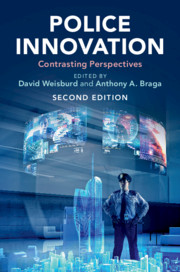Book contents
- Police Innovation
- Police Innovation
- Copyright page
- Contents
- Figures
- Tables
- Notes on Contributors
- Introduction
- Part I Community Policing
- Part II Procedural Justice Policing
- Part III Broken Windows Policing
- Part IV Problem–Oriented Policing
- Part V Pulling Levers (Focused Deterrence) Policing
- Part VI Third–Party Policing
- Part VII Hot Spots Policing
- Part VIII Predictive Policing
- Part IX CompStat
- Part X Evidence-Based/ Risk-Focused Policing
- Part XI Technology Policing
- 21 Advocate
- 22 Critic
- Conclusion
- Index
- References
Conclusion
Police Innovation and the Future of Policing
from Part XI - Technology Policing
Published online by Cambridge University Press: 09 August 2019
- Police Innovation
- Police Innovation
- Copyright page
- Contents
- Figures
- Tables
- Notes on Contributors
- Introduction
- Part I Community Policing
- Part II Procedural Justice Policing
- Part III Broken Windows Policing
- Part IV Problem–Oriented Policing
- Part V Pulling Levers (Focused Deterrence) Policing
- Part VI Third–Party Policing
- Part VII Hot Spots Policing
- Part VIII Predictive Policing
- Part IX CompStat
- Part X Evidence-Based/ Risk-Focused Policing
- Part XI Technology Policing
- 21 Advocate
- 22 Critic
- Conclusion
- Index
- References
Summary
In this volume, a group of leading scholars presented contrasting perspectives on eleven major innovations in American policing developed over the course of the last three decades. Police departments needed to improve their performance and relationships with the community and innovation provided the opportunity to make these improvements. These innovations represent fundamental changes to the business of policing. However, as many of our authors point out, improving police performance through innovation is often not straightforward. Police departments are highly resistant to change and police officers often experience difficulty in implementing new programs (Sparrow, Moore, & Kennedy, 1990; Bayley & Nixon, 2010; Maguire, 2014; Lum & Koper, 2017). The available evidence on key dimensions of police performance associated with these innovations, such as crime control effectiveness and community satisfaction with services provided, is sometimes limited. These observations are not unique to the policing field. For example, as Elmore (1997) suggests, the field of education was awash in innovation during the 1990s, but there is little evidence examining whether those innovations advanced the performance of schools, students, or graduates.
- Type
- Chapter
- Information
- Police InnovationContrasting Perspectives, pp. 544 - 563Publisher: Cambridge University PressPrint publication year: 2019
References
- 1
- Cited by



